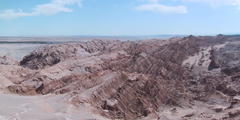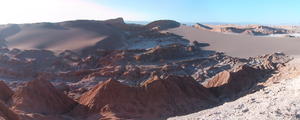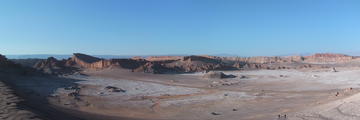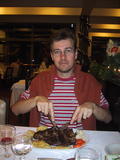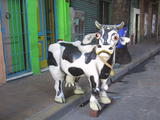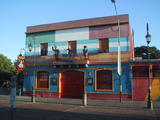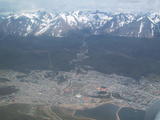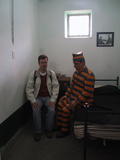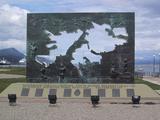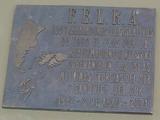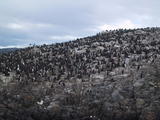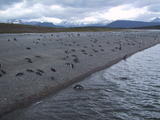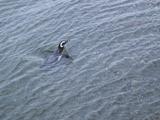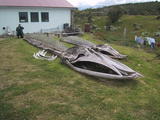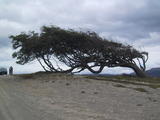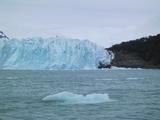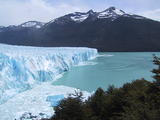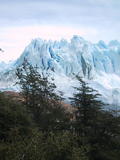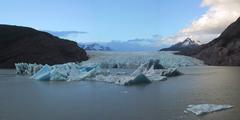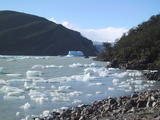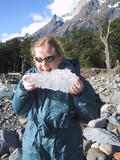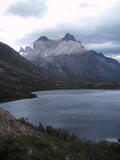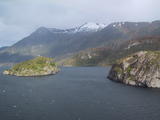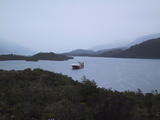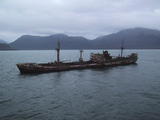| < < < Previous story | Next story > > > | |
Glaciers and fjords in the southern coneConcepción (Paraguay), 9 February 2004
Contents:ChileComing from Bolivia, San Pedro de Atacama was somewhat disappointing, just a couple of tree-less dirt streets, extremely expensive (especially by Bolivian standards), no ATMs, bad exchange rates for the US Dollar, even worse ones for the Euro and Internet so slow as not to be really usable. It surprised me that the Lonely Planet guide speaks so well of this town, since who likes to get road dust kicked up by passing cars on their overpriced pizzas? However the nice thing about San Pedro is what is outside the town, surroundings such as Moon Valley or the, nearly impossible to reach, hot pools. After having failed for the 3rd day in a row to find out which tap in the shower had the promised warm water, we finally left for Santiago, by overnight bus. The best bus we had taken until then. Seats were spaced out, 2 on the left side and 1 on the right, with enough space to incline our king size seat nearly horizontally. We managed to catch a good night's sleep until the bus unfortunately broke down at 07:00. One hour later a more conventional bus from the same company picked us up for the remainder of the trip. Upon arriving in Santiago, customer service, gave us a significant refund. Amazing! Was this still South America? It really did seem as if we had arrived on a different continent, Santiago, is more like a well organized and relatively clean European city than like anything else we had seen in the Americas so far. A subway system is usually quite telling, Santiago's is efficient and clean. Still traveling with Erik and Chisako, we were fortunate enough to again be offered a multi-room apartment for the four of us, located just outside the center of Santiago. We decided to explore the city and enjoy the nightlife this city had to offer. Argentinian BeefOur days in Santiago were limited, as Erik and Chisako had to catch their flight from Buenos Aires on Christmas eve. Therefor we crossed the Andes by bus to Mendoza, the heartland of Argentinian wine, before heading on to Buenos Aires. In the couple of days we had left together, we explored the different parts of Buenos Aires and enjoyed its nightlife and culinary offerings. We feasted on Argentinian steaks, the most delicious tenderloins I have ever eaten, in one of Buenos Aires' most famous restaurants, La Chacra. This country is known to have the best beef in the world! It is not just a story, it's true! Unfortunately this meat, grown in the Pampa, far away from pollution, is nearly impossible to find in Europe, a market "protected" from competition, mostly for the benefit of French farmers, through a scheme called the Common Agricultural Policy (or rather Crazy Agricultural Policy), whereby any imported food products such as meat are taxed exorbitantly. The tax on Argentinian beef is said to be 400%! Not surprisingly meat in Argentina costs about a fifth of what it costs in Europe, but the quality is so much better. We have French President Chirac and German Chancellor Schroeder to thank for thwarting recent attempts to reform the CAP. Thus keeping Argentinian meat off our plates in Europe for the sake of pleasing the farming lobby. But it is not only that, it gets even worse! European food products are exported with subsidies. For example a quantity of meat that would be sold for 100 Euros in the European Union gets 80 Euros export credit so that it can be sold at the much lower price of 20 Euros outside of the European Union. Thus our taxes are used to destroy the livelihood of millions of farmers in developing countries, who can not compete against these subsidies. The Holidays in Uruguay and Buenos AiresOn Christmas eve Erik and Chisako left for Holland. We stayed in Buenos Aires to organize the next couple of weeks of our trip, to Patagonia and Tierra del Fuego, as well as to celebrate Christmas and New Year. Between Christmas and New Year we visited Uruguay, crossing the Plata estuary, to Montevideo by boat, spending two nights in Montevideo, returning by bus and boat over Colonia where we spent 4 hours. There was really not that much to do in Uruguay, Montevideo is much smaller than Buenos Aires and some sections fairly close to the center are not so safe. Colonia warrants a visit of about 4 hours, that is all the time you need to walk around the town, see its colonial style buildings, climb the lighthouse and have a meal. From Colonia you can just make out the Buenos Aires skyline across the estuary. We were back in Buenos Aires for New Year, where the real partying starts well after midnight, and lasts until 08:00. We visited a couple of dancing places and discos, such as Azucar and Buenos Aires News, together with 3 Californians we had met earlier. Tierra Del FuegoThe rest of New Year's day was not very productive, but we had to pack again, because on January 2nd at 07:30 we were flying to Ushuaia (more than 3000 km south). This flight was with the Argentinian air force, or rather with their passenger service called L.A.D.E. (Lineas Aereas Del Estado, which translates to Air Lines of the State). They fly old Fokker F28 and F27 airplanes and the tickets are pretty cheap if you can get one (281 Pesos or approx. 80 Euros for the flight to Ushuaia). Ushuaia, which markets itself as the city at the end of the world, is known as the southernmost town in the world, but is technically speaking not the southernmost town since Puerto Williams, across the Beagle channel in Chile is more to the south. But it can be debated that Puerto Williams is not really a town as it lacks the facilities and size of Ushuaia. First a bit of history about the southern most part of the Americas. Europeans discovered Tierra del Fuego in 1520 when Magellan sailed through the straight that now carries his name and found the first route from the Atlantic to the Pacific. The land was named the land of fire because they saw the island dotted with fires. The natives relied on fire and smeared animal grease on their bodies to keep themselves warm as they did not wear clothes. Animal skins would hardly ever dry up in the weather of Tierra del Fuego, so could not keep them warm. Schouten and Le Maire found an alternative route from the Atlantic to the Pacific in 1616, via what is now called Cape Horn, named after the Dutch city of Hoorn that sponsored their expedition. Two expeditions of the Beagle explored the region more thoroughly in 1829 and 1831. They discovered what is now called the Beagle channel, the waterway on which Ushuaia is located. One passenger on these expeditions was Charles Darwin, who wrote about it in his book "The voyage of the Beagle". More recently, in 1978, Argentina, under the dictatorship of General Leopoldo Galtieri, nearly went to war with Chile over three small islands at the eastern end of the Beagle channel. Only the last minute intervention by pope John Paul II averted this and the islands remained Chilean. But the unpopular military dictatorship, looking for a way to divert attention from economic problems and unify the country behind it, later unleashed another war when it invaded the Falklands Islands (called Malvinas in Spanish). For General Galtieri this was the beginning of the "recuperation" of all the territories that "belong" to Argentina. Chile felt threatened again and chose to side with Great Britain, providing it with its intelligence on Argentinian forces. Argentina suffered a humiliating defeat, which led to a return to civilian rule. Unfortunately the Argentinians left the islands littered with undocumented minefields. Recent HistoryNow, more than 20 years later, every map in Argentina still shows the Falklands and several other South Atlantic islands as part of Argentina, as well as a whole slice of Antarctica. I even found a stamp celebrating "the first recuperation of the South Atlantic Islands (1982)"! There is a memorial of the war in Ushuaia and many streets around the country are named "Malvinas Argentinas". At a border crossing I saw a sign reading: "Las Malvinas son Argentinas" (The Falklands are Argentinian). As if losing the war was not enough, Argentina underwent the collapse of its financial system at the end of 2001. When the current Argentinian president, Kirchner, says things like "Nobody criticizes Argentina, we will no longer be a carpet!" as he did in a speech on January 7th, 2004 in front of a cheering crowd, does it show how deeply national pride has been hurt and the trouble the country still is in? The current government is refusing to pay back private bond holders representing 76% of Argentina's 100 billion US dollar debt, 60% of whom are non-Argentinians, who, fortunately for the government, have no right to vote. Unfortunately for Argentina, some of these investors have already managed to freeze Argentinian assets overseas. It serves as a warning to investors world wide to be very careful when investing in developing countries' debt. As a last resort the Argentinian government turned to the IMF and the World Bank as nobody else in his right mind will lend this country anything anymore, but instead of keeping its side of the bargain the government now uses these institutions as scapegoats. Yet how visible are all of Argentina's problems? They are not! Everything seems really normal, people go about their daily business, streets and buildings look relatively well maintained. There is only one thing: things are cheap. In 2001 the Argentinian Peso was worth 1 US dollar, but now nearly 3 pesos go in to a dollar, inflation has only partially corrected the devaluation, making things roughly 50% cheaper than in 2001 as measured in US dollars. In the mean time a Euro gets you 1.25 US dollars against 85 US cents in 2001, so for Europeans there is a double benefit in Argentina. However the quality of services is at a European level, things are organized and they work. The roads are good, buses are fine, services run on time, hostels are clean, there is always warm water and the food is great. I really want to emphasize the last aspect, we have had absolutely great food everywhere in Argentina, there is of course the meat on which I elaborated before, but also great pizzas and pastas, trout in Bariloche, sea food in Ushuaia even the sushi in Buenos Aires was among the best we ever had. This may have something to do with the fact that many Argentinians are of Italian descent, a country itself renowned for its cuisine. UshuaiaLet's get back to Ushuaia, there are a couple of things to see and do around the town. Walks in the national park, a cruise on the Beagle channel, climbing to the glacier (not an impressive glacier) and a trip to Harberton and the nearby Penguin colony. Harberton also has a marine mammal research station where you can see the skeletons of large whales and learn why an orca (also known as killer whale) is not a whale but a dolphin. Ushuaia is also a port from which to start Antarctica cruises, but these are quite expensive, so we had to leave that for the future. Another point of interest are the otter dams, an introduced species, that, unchallenged by predators, is wreaking havoc on the forests of Tierra del Fuego, changing river courses and flooding whole areas, killing trees. The otters show us yet again the damage introduced species can cause. Another introduced species, humans from Europe, wreaked havoc as well, of the 4 indigenous groups that used to live in Tierra del Fuego, none survived. Most succumbed to European diseases or were incapable to adapt to European society and the resulting competition for natural resources. Perito Moreno GlacierWe were lucky to get the last two seats, on a L.A.D.E. flight out of Ushuaia to El Calafate as this was only a couple of pesos more expensive than the bus and would save us a lot of time. El Calafate is the booming tourist town on the shores of Lago Argentino, Argentina's largest lake, close to the Perito Moreno glacier, supposedly the world's most active glacier, advancing up to 2 meters per day in the center and 50 cm per day at the sides. As it touches the lake the glacier is constantly calving. It is one of the most impressive natural spectacles to watch. Large blocks of ice break off the glacier and slowly float away as icebergs. While we were there the glacier had progressed so far that it blocked the southern branch of the lake, making the water there rise by about 4 meters. If the glacier holds past the summer, the water will rise to such a point that the pressure will force water to tunnel through the glacier, eventually causing it to collapse. The last time this happened was in 1988. Chilean Mountains and FjordsWe crossed the border to Chile again, to reach Puerto Natales, were we got blown away by the wind and rain. This small town is the place to organize a tour to Torres del Paine. We also had to check if our e-mail/fax booking for the boat to Puerto Montt had been successful, the process had taken several weeks, the feedback from Navimag, the company that operates the boat was pretty slow and the fax number they gave was not operational. Torres del Paine (Towers of Paine) is a large nature reserve, with incredible scenery, you need at least 5 days to see the reserve, but we only had 3 days. We chose to walk to the Grey glacier and Valle Francés (French valley). The glacier feeds a lake, lago Grey, in which ice blocks that broke off the glacier float around as icebergs. A truly amazing sight. Near the glacier you can pick up pieces of ice out of the lake and observe their perfect transparency. We spent one night in the refugio near the glacier, walking back to the Pehoe camp the next day, unfortunately we had to spend that night in a tent. There was so much wind and it was so cold, that this was a rather unpleasant experience. On our last day we walked to Valle Francés, from which you are supposed to be able to see all the high peaks. Unfortunately mother nature made this impossible with a thick cloud cover. Our time in Patagonia was coming to an end, from Puerto Natales we got on the Navimag ferry to Puerto Montt, spending 3 days and 4 nights navigating through the Chilean fjords. We spent those days watching the untouched scenery roll by, looking at mountains rising steeply out of the water, watching the ship pass through narrow channels, passing a shipwreck, viewing wildlife and seeing whales spray water into the air just meters from the ship. On board were several interesting presentations and documentaries that could be followed, some were about the wildlife we could see from the boat or had seen in Patagonia and Tierra del Fuego. Here is a short list of some of the native animals that we have seen:
Why don't polar bears eat penguins? The reason is that polar bears live in the northern hemisphere and penguins live in the southern hemisphere! However we had seen penguins in the Galapagos, which is just on the equator. It turns out that the archipelago is host to the northernmost penguin colony, they can survive there due to a cold water current from the Antarctic. After 3 days at sea, we arrived in Puerto Montt, where we took a bus to nearby Puerto Varas, to spend our last days in Chile. If you would like to be notified when we write more about our trip, just send us an E-mail. e-mail Otto de Voogd PhotosSan Pedro de AtacamaBuenos AiresUshuaia and Tierra del FuegoPerito Moreno GlacierTorres del PaineChilean Fjords (Navimag Ferry)Practical Information
To my knowledge the information provided here was accurate
at the time of our visit. However time passes and things can change.
Transportation
Money(ATMs for Maestro/Cirrus bankcards)
Chile: All ATMs
CostsNote: The exchange rates changed somewhat during the trip. Chile - Pesos, approx. rates: 1 USD = 600 CLP, 1 EUR = 720 CLP
San Pedro de Atacama - Residencial Licanbur:
10,000 CLP per room with shared bath, the promised warm water
never materialized, totally overpriced.
Argentina - Pesos, approx. rates: 1 USD = 2.85 ARS, 1 EUR = 3.60 ARS
Mendoza - Hotel Zamara: 45 ARS (checkout time 10:00)
Uruguay - Pesos, approx rates: 1 USD = 28.90 UYU, 1 EUR = 36.00 UYU
Montevideo - Hotel Palacio: 400/450 UYU (or 15/17 USD).
The two more expensive rooms on the 6th floor have a large
balcony with a great view.
Argentina - Pesos, approx. rates: 1 USD = 2.85, 1 EUR 3.65 ARS
Flight - Buenos Aires -> Ushuaia (with L.A.D.E.):
281 ARS + 6 ARS airport tax per person
Chile - Pesos, approx. rates: 1 USD = 560 CLP, 1 EUR 715 CLP
Puerto Natales - Residencial El Mirador: 12,000 CLP per room
with private bath. well kept, but too far out of town and has
pushy owner, not recommended.
| ||
| < < < Previous story | Next story > > > | |
New | About | Contact | Connect | Friends | Promotions | Copyright | Advertise
